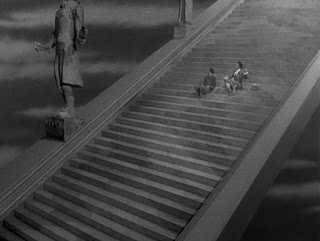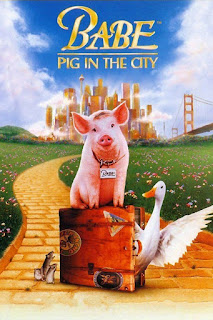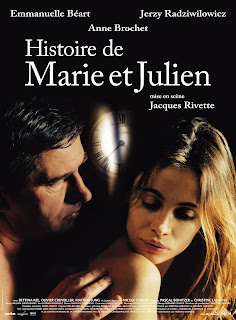June 1st: A MATTER OF LIFE AND DEATH (Powell & Pressburger, 1946)
During World War II, a British fighter pilot slated for certain death in a crash accidentally survives due to a clerical error, and must present his case for remaining alive at a court hearing in heaven.
The team of Michael Powell and Emeric Pressburger lasted for over 30 years, and was responsible for 24 films. Pressburger fled his home country of Hungary during World War II, and eventually wound up in London working for fellow Hungarian emigre and independent producer Alexander Korda, where he met Powell in 1939. Within four years they had created their own production company, referring to themselves as "The Archers", and opted to share screen credit for writing, directing, and producing.
The sophistication of the Archers' work evolved quickly during the war, and despite their controversial film The Life and Death of Colonel Blimp (1943) with protests by Churchill and the war department, the pair were asked to make a film to improve post-war relations between British citizens and Americans who had been stationed there during the fighting. With complete creative control, they devised their most ambitious film to date, using the fantasy genre to highlight their themes.
Two elements slowed production down considerably: the long wait for Technicolor film stock and cameras (ironically being used up by the U.S. Army), and the construction of the enormous, 106-step "stairway to heaven" escalator prominently shown in the film, built over the course of three months and costing almost $200,000 in today's dollars. The courtroom set featured a backdrop 40 ft high and 350 ft wide. The international crew also included German artists Alfred Junge and Hein Heckroth on production and costume design, the pair working on a combined 10 films for the Archers.
Behind the camera was Jack Cardiff in his first of three now-legendary collaborations with the Archers; Cardiff was one of the first British cinematographers to work with Technicolor, was a adept student of painting, and whose creativity and resourcefulness could match Powell and Pressburger's ambition. The Archers made the decision to film all the "other world" scenes in black & white, presenting additional complications with the Technicolor process.
The cast was headed by British actor David Niven (The Pink Panther), who had actually got his start in Hollywood in the 1930s, achieving considerable popularity, before returning to England in 1939 right after it declared war on Germany to enlist. He worked primarily in the film unit but saw action in the Invasion of Normandy as a signaler. Also starring is American actress Kim Hunter (A Streetcar Named Desire), previous Archers collaborators Roger Livesey (Colonel Blimp) and Marius Goring (The Red Shoes), Richard Attenborough (Jurassic Park), and Canadian actor Raymond Massey (East of Eden).
The film was selected to be the first Royal Film Performance, an annual premiere screening in front of the royal family. It was a considerable success with critics and at the box office at home as well as abroad, released in the United States with the title Stairway to Heaven. It was ranked #20 on a 1999 British Film Institute industry poll of the Top 100 British Films (where three other Archers films also placed), and #2 on a 2004 critics' poll in UK magazine Total Film.
Running time is approx. 100 minutes.










Comments
Post a Comment